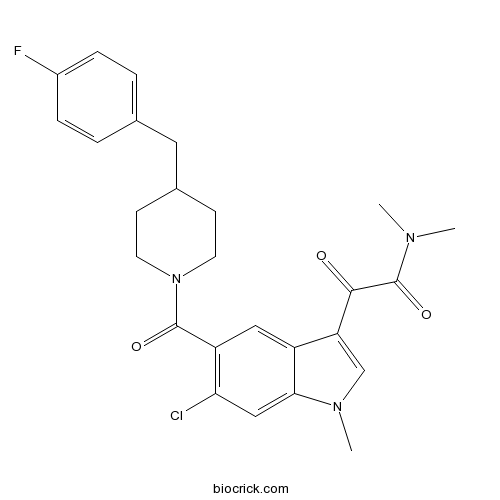SX 011CAS# 309913-42-6 |

- StemRegenin 1 (SR1)
Catalog No.:BCC3637
CAS No.:1227633-49-9
Quality Control & MSDS
3D structure
Package In Stock
Number of papers citing our products

| Cas No. | 309913-42-6 | SDF | Download SDF |
| PubChem ID | 9935015 | Appearance | Powder |
| Formula | C26H27ClFN3O3 | M.Wt | 483.96 |
| Type of Compound | N/A | Storage | Desiccate at -20°C |
| Solubility | Soluble to 100 mM in DMSO and to 100 mM in ethanol | ||
| Chemical Name | 2-[6-chloro-5-[4-[(4-fluorophenyl)methyl]piperidine-1-carbonyl]-1-methylindol-3-yl]-N,N-dimethyl-2-oxoacetamide | ||
| SMILES | CN1C=C(C2=CC(=C(C=C21)Cl)C(=O)N3CCC(CC3)CC4=CC=C(C=C4)F)C(=O)C(=O)N(C)C | ||
| Standard InChIKey | GUTYHDCSDBBMGW-UHFFFAOYSA-N | ||
| Standard InChI | InChI=1S/C26H27ClFN3O3/c1-29(2)26(34)24(32)21-15-30(3)23-14-22(27)20(13-19(21)23)25(33)31-10-8-17(9-11-31)12-16-4-6-18(28)7-5-16/h4-7,13-15,17H,8-12H2,1-3H3 | ||
| General tips | For obtaining a higher solubility , please warm the tube at 37 ℃ and shake it in the ultrasonic bath for a while.Stock solution can be stored below -20℃ for several months. We recommend that you prepare and use the solution on the same day. However, if the test schedule requires, the stock solutions can be prepared in advance, and the stock solution must be sealed and stored below -20℃. In general, the stock solution can be kept for several months. Before use, we recommend that you leave the vial at room temperature for at least an hour before opening it. |
||
| About Packaging | 1. The packaging of the product may be reversed during transportation, cause the high purity compounds to adhere to the neck or cap of the vial.Take the vail out of its packaging and shake gently until the compounds fall to the bottom of the vial. 2. For liquid products, please centrifuge at 500xg to gather the liquid to the bottom of the vial. 3. Try to avoid loss or contamination during the experiment. |
||
| Shipping Condition | Packaging according to customer requirements(5mg, 10mg, 20mg and more). Ship via FedEx, DHL, UPS, EMS or other couriers with RT, or blue ice upon request. | ||
| Description | Potent p38α inhibitor (IC50 = 9 nM). Also inhibits p38β and JNK-2 (IC50 values are 90 nM and 100 nM respectively). Displays no significant activity at p38γ, p38δ, ERK-2 and JNK-1. |

SX 011 Dilution Calculator

SX 011 Molarity Calculator
| 1 mg | 5 mg | 10 mg | 20 mg | 25 mg | |
| 1 mM | 2.0663 mL | 10.3314 mL | 20.6629 mL | 41.3257 mL | 51.6572 mL |
| 5 mM | 0.4133 mL | 2.0663 mL | 4.1326 mL | 8.2651 mL | 10.3314 mL |
| 10 mM | 0.2066 mL | 1.0331 mL | 2.0663 mL | 4.1326 mL | 5.1657 mL |
| 50 mM | 0.0413 mL | 0.2066 mL | 0.4133 mL | 0.8265 mL | 1.0331 mL |
| 100 mM | 0.0207 mL | 0.1033 mL | 0.2066 mL | 0.4133 mL | 0.5166 mL |
| * Note: If you are in the process of experiment, it's necessary to make the dilution ratios of the samples. The dilution data above is only for reference. Normally, it's can get a better solubility within lower of Concentrations. | |||||

Calcutta University

University of Minnesota

University of Maryland School of Medicine

University of Illinois at Chicago

The Ohio State University

University of Zurich

Harvard University

Colorado State University

Auburn University

Yale University

Worcester Polytechnic Institute

Washington State University

Stanford University

University of Leipzig

Universidade da Beira Interior

The Institute of Cancer Research

Heidelberg University

University of Amsterdam

University of Auckland

TsingHua University

The University of Michigan

Miami University

DRURY University

Jilin University

Fudan University

Wuhan University

Sun Yat-sen University

Universite de Paris

Deemed University

Auckland University

The University of Tokyo

Korea University
- Dauricinoline
Catalog No.:BCC8162
CAS No.:30984-80-6
- Vinyl Cinnamate
Catalog No.:BCN5041
CAS No.:3098-92-8
- GW791343 HCl
Catalog No.:BCC4974
CAS No.:309712-55-8
- 1,5-Dicaffeoylquinic acid
Catalog No.:BCN5913
CAS No.:30964-13-7
- 2-Amino-9H-fluoren-9-one
Catalog No.:BCC8545
CAS No.:3096-57-9
- Perillartine
Catalog No.:BCN8305
CAS No.:30950-27-7
- Doxifluridine
Catalog No.:BCC4903
CAS No.:3094-09-5
- Inauhzin
Catalog No.:BCC5146
CAS No.:309271-94-1
- Boc-Asp-OBzl
Catalog No.:BCC3363
CAS No.:30925-18-9
- Boc-N-Me-Phg-OH
Catalog No.:BCC3350
CAS No.:30925-11-2
- 3β-Acetoxy-5α-androstan-17β-ol
Catalog No.:BCC8644
CAS No.:3090-70-8
- 8-Epixanthatin
Catalog No.:BCN7782
CAS No.:30890-35-8
- Boc-Aib-OH
Catalog No.:BCC3148
CAS No.:30992-29-1
- KL 001
Catalog No.:BCC6262
CAS No.:309928-48-1
- 3-(Boc-Amino)piperidine
Catalog No.:BCC8590
CAS No.:309956-78-3
- 7-O-Methylmangiferin
Catalog No.:BCN2804
CAS No.:31002-12-7
- 1-O-(3,4-Dimethoxybenzoyl)-beta-D-glucopyranose
Catalog No.:BCN3759
CAS No.:31002-27-4
- 7-Ethoxycoumarin
Catalog No.:BCN2708
CAS No.:31005-02-4
- Magnolin
Catalog No.:BCN5224
CAS No.:31008-18-1
- Fargesin
Catalog No.:BCN5022
CAS No.:31008-19-2
- Dihydrosphingosine
Catalog No.:BCC6778
CAS No.:3102-56-5
- Ceramide
Catalog No.:BCC2458
CAS No.:3102-57-6
- Echinophyllin C
Catalog No.:BCN5225
CAS No.:310433-44-4
- Spaglumic acid
Catalog No.:BCC6632
CAS No.:3106-85-2
MAP kinase p38 inhibitors: clinical results and an intimate look at their interactions with p38alpha protein.[Pubmed:16378500]
Curr Med Chem. 2005;12(25):2979-94.
Mitogen-activated protein kinase p38 is a serine/threonine kinase originally isolated from lipopolysaccharide (LPS) stimulated monocytes. There are four isoforms p38alpha p38beta, p38gamma, and p38delta. The most thoroughly studied isoform is p38alpha, whose activation has been observed in many hematopoietic and non-hematopoietic cell types upon appropriate stimuli. Subsequently, p38alpha kinase has been shown to be involved in the biosynthesis of TNFalpha and IL-1beta at the translational and transcriptional level. MAP kinase p38alpha represents a point of convergence for multiple signaling processes that are activated in inflammation and thus a key potential target for the modulation of cytokine production. The discovery and publication of p38alpha and the pyridinyl-imidazole inhibitor initiated a huge effort by many companies to develop p38alpha inhibitors as potential treatment for inflammatory diseases. Herein we provide a brief overview of recent reported clinical results for AMG 548, BIRB 796, VX 702, SCIO 469, and SCIO 323. However, our focus will be on the binding modes of these inhibitors and other p38 inhibitors in the recent literature.


